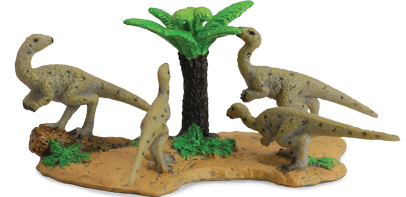Notes on the Remarkable Hypsilophodon
Notes on Hypsilophodon – one of the most studied of all Dinosaurs
With the recent new research into the intercostal plates on Hypsilophodon being published we thought it an appropriate time to produce a brief article on Hypsilophodon a small, bipedal ornithopod whose importance to palaeontologists is often overlooked.
At least two species of Hypsilophodon are known, the best known and the one with the most fossil material is Hypsilophodon foxii, however, a second species of Hypsilophodon – H. wielandi has been identified from an isolated femur (thigh bone) found in the USA, but this identification and interpretation has been disputed by a number of scientists as the fossil is indeterminate.
The first remains of any hypsilophodontid to be discovered were found in the a slab of sandstone from the coast of the Isle of Wight in 1849. The remains, which consisted of a partial skeleton were first thought to be of a young Iguanodon, an animal that had been described in 1825 and whose fossils had been found in the same strata. By 1868 several near complete skeletons had been recovered from the same area by the amateur naturalist the Reverend William Fox.
This new material displayed several characteristics not known in Iguanodontids and it was proposed that these fossils plus the one found in 1849 did in fact represent a new species of Iguanodon. This dinosaur was named Iguanodon foxii in honour of the Reverend’s work.
Another renowned English scientist, Thomas Henry Huxley noted that these “miniature iguanodontids” had many differences between them and other known Iguanodon species. One notable difference was the teeth which were narrower and more sharply pointed than Iguanodon teeth. This prompted Huxley to rename this dinosaur in 1896. He called it Hypsilophodon foxii. The name means “high ridge tooth” in recognition of one of its most distinguishing features. The name is pronounced – hip-sih-low-foh-don.
In 1882, James W Hulke published a paper in the highly influential scientific journal – “The Quarterly Proceedings of the Geological Society”. He concluded that this little dinosaur was adapted for climbing over rocks and living in trees because of its long fingers and toes plus it could use its tail as a counterbalance, a bit like a modern tree-kangaroo.
A number of other anatomical features were described including the fact that Huxley believed that the first digit of the foot was reversed like a bird’s hallux claw. This would have helped Hypsilophodon to perch on branches. We now know this was an inaccurate interpretation and Hypsilophodon was a fleet-footed and most definitely terrestrial dinosaur.
Hypsilophodon – a Dinosaur Model Set?
To view the CollectA model range: CollectA Prehistoric Life Models.
So much Hypsilophodontidae material has been recovered from one particular area of the Isle of Wight that the strata has been named the Hypsilophodon bed, it is unusual to find so many vertebrates preserved together in one place, the specimens show little sign of attack by scavengers and it has been suggested that these animals represent part of a herd that became trapped and perished in some inter-tidal quicksand.
Article on new Hypsilophodon research: New Insight into Hypsilophodon.


